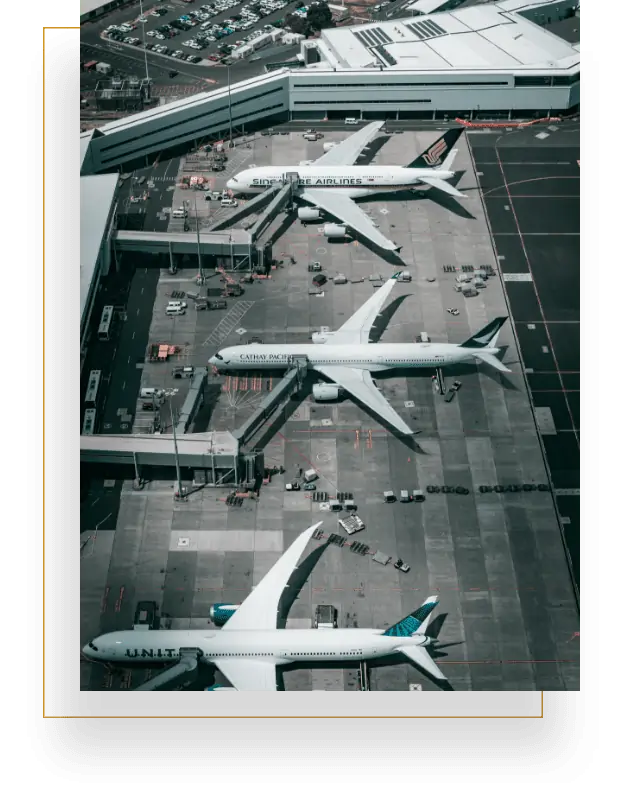Superb Ground Handling Services to Facilitate Your Aircraft Flight

A Successful Flight
Begins at Ground
JBS dedicated experts partner with qualified, IATA-certified ground handlers to provide you with efficient, secure, and reliable airport services globally.
We arrange ground handling for VIP and government flights, private jet and passenger commercial charters, and cargo transport while meeting safety standards of aircraft ground times.
Ground operations involve key performance indicators of place, time, and profitability. It is a complex and sensitive activity that can generate delays and risks. That’s why incidents are very diverse and require situational awareness of airport operations.
Poor door locking, errors in fuel quantity, or even approximate cargo stowage, are undesirable events, some of which may have catastrophic consequences.
No matter where you fly, we will ensure the availability of all the necessary ground support equipment, technologies, and facilities in the requested location to accommodate your needs.
The modern era of air travel has seen airlines take on new roles – be they cargo carriers, low-cost carriers, full-service carriers, regional carriers, or leisure carriers. But no matter how big or small, every single one of them requires efficient ground handling.
Jet Business Solutions Aviation’s ground handling solutions provide the highest level of convenience for our customers. From the ramp to the gate, we deliver efficient, safe, and secure ground handling services to airports across the globe.
Whether transporting VIPs, cargo, passengers, or livestock, we pride ourselves on providing quality ground handling services that exceed expectations while ensuring high levels of safety.
With a proven track record in aviation, JBS Aviation offers superior ground handling services from pre-flight planning to post-landing care. Our fleet of fully equipped vehicles handles a wide variety of ground assignments including but not limited to:
- Ramp handling: aircraft pushback and towing, offloading and loading, Ground Power Unit (GPU), Air-starter Unit (ASU), Air-conditioning Unit (ACU), provision of toilet and water servicing.
- Passenger handling: passenger boarding bridge, meet & greet, check-in, and boarding assistance.
- Cargo handling: warehousing, build-up and breakdown, documentation, live animals (AVI), and Dangerous Goods (DGR) handling.
- Customs and immigration assistance.
- Load control, weight, and balance calculations.
- Fuelling supervision.
- De-icing and anti-icing services.
- ATC and airport slot coordination.
- Cleaning service for aircraft interior and exterior.
- NOTAM, weather, and flight documentation.
- Lounges access for VIP and crew areas.
- Airside transport of passengers and crews.
- Catering arrangement and delivery.
- Visa assistance.
- Concierge services with ground transfer and hotel accommodation arrangement.
- Live updates of all processes.
Investing in airport assistance equipment is not a decision to be taken lightly. You must be confident that you are getting the best value for money.
Trusting JBS is a good starting point. Our ground handling equipment is renowned in the industry of aviation handling for all the right reasons. Our airport ground equipment comes with many features and options, such as
- Diesel or all-electric
- High speed and maneuverability
- Advanced diagnostics
- Suitable for commercial aircraft and cargo aircraft
What else does JBS aircraft ground support equipment have to offer? A lot, and all to your advantage.
All these services combined give us an edge over others in this business.
If you would like more details about how JBS aircraft ground support equipment can improve your airline’s efficiency and profitability, contact us now!
Ground
Handling
Frequently
Asked Questions
How does ground handling work?
Ground handling operations and activities start when the incoming aircraft arrives at the airport. Assigning airport gates to arriving aircraft is part of airport management. It includes assessing already occupied gates and types of arriving aircraft. Airline and ground handling agency staff inspect GSE before an aircraft arrives. The ground support equipment is moved to the ramp when an aircraft lands.
Once an aircraft has landed, air traffic control informs its pilot of the allocated gate and which route to take.
Meanwhile, airline and GSE staff conduct pre-flight inspections of ground support equipment to ensure all equipment works properly before the plane lands. They will tow your vehicle to the ramp to avoid delays if you park somewhere else.
Why aircraft marshalling is needed?
Aircraft marshaling ensures that aircraft are correctly positioned and oriented on the ramp. Stop bars are needed to mark the position of the aircraft on the ramp. Different aircraft require different positioning on the ramp. Centerlines and stops are clear with red paint or yellow tape. All aircraft must be guided to the correct position by a marshaller.
How do aircraft ground handlers coordinate arrivals or departures of aircraft?
They typically use communication systems called Traffic Alert and Collision Avoidance Systems. An electronic display board showing the direction of traffic flow behind each landing gear. They also use radio communications between pilots and controllers to coordinate arrival routes and departure times.
Who takes care of the aircraft after it lands?
After the aircraft land safely, the airport personnel or ground handling agent removes any cargo or other items from the aircraft hold and then loads those items onto another ground vehicle. It is important to coordinate these actions so that all aircraft land in time.
Why do I need ground handling services?
Ground handling operations before each landing assures pilots and passengers that everything is safe. Airport security personnel perform regular checks and verify the closure of landing gear doors, shutting down engines, setting flaps, and following other operating procedures. In addition, the use of ground power units helps reduce fueling costs. By eliminating taxi time between runways, the aircraft can quickly reach their assigned gates. And airport security officers can spot potential threats more easily because fewer people are required to monitor the area.
Let’s Talk Flights…